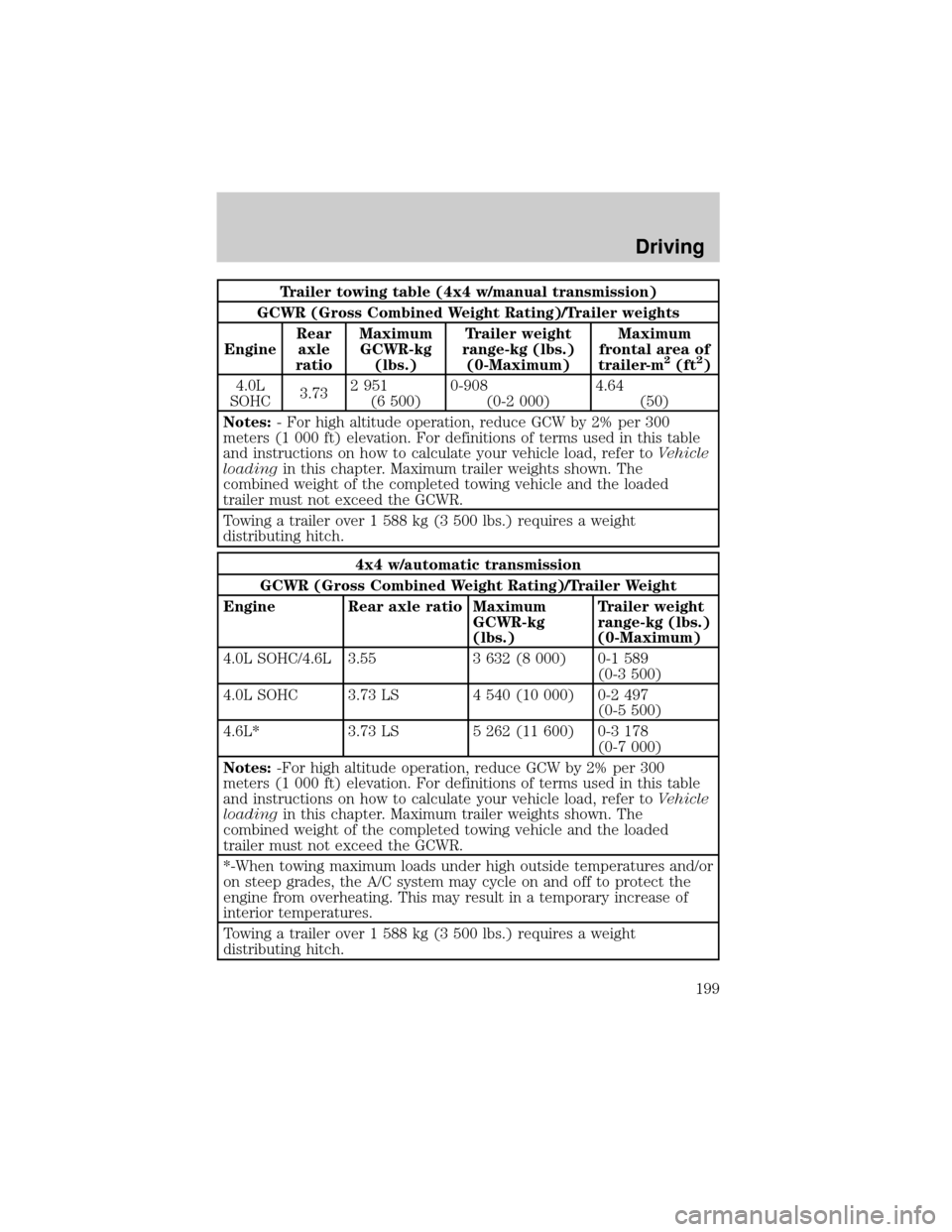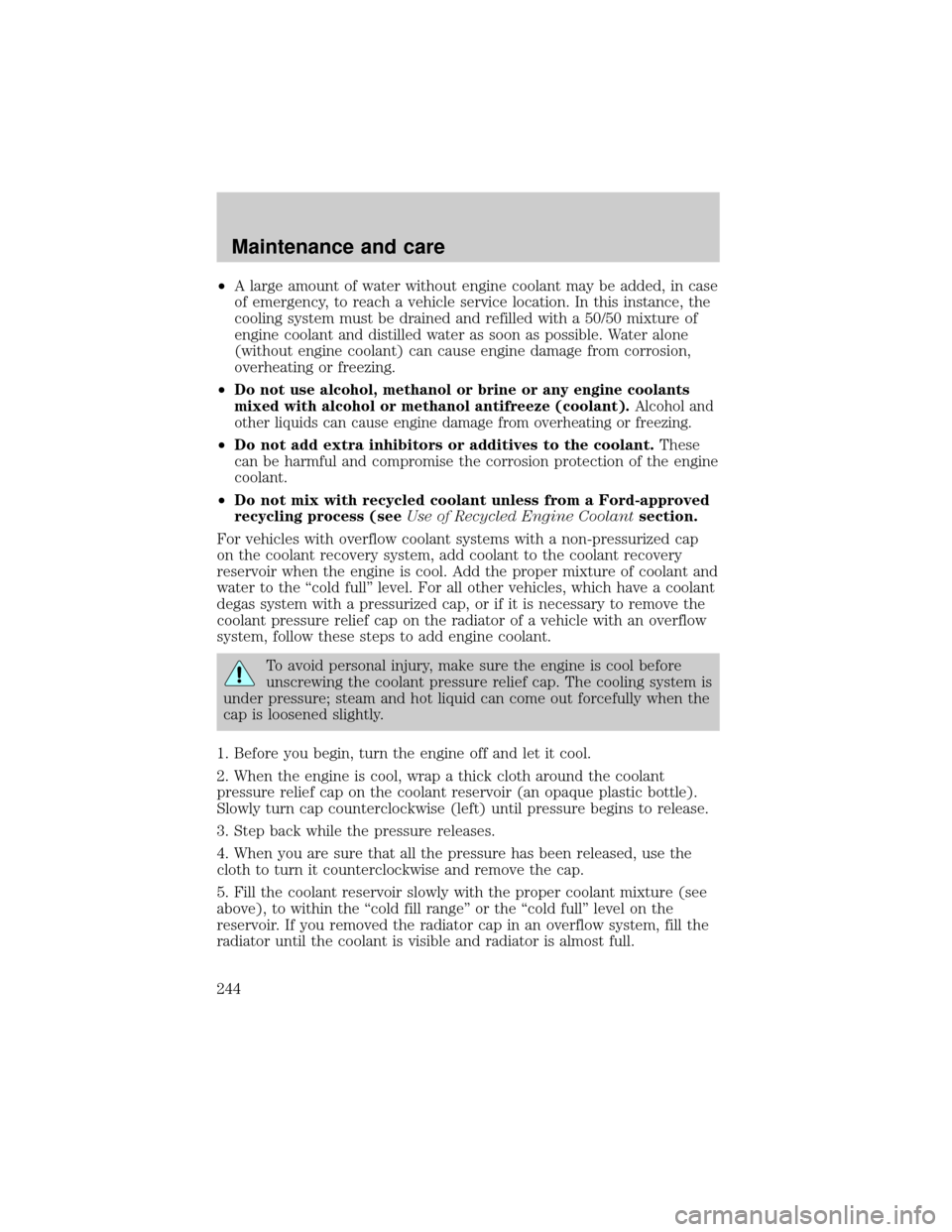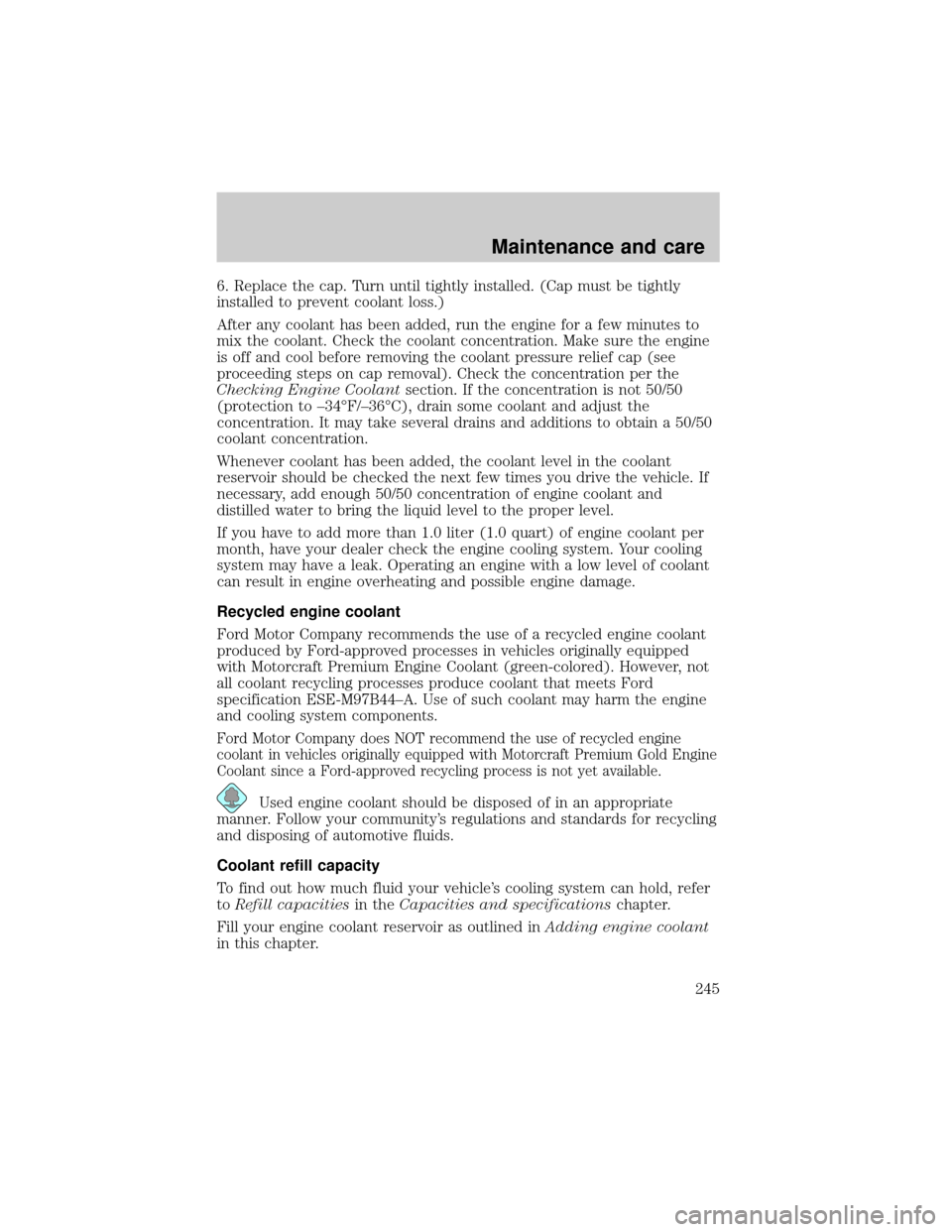2002 FORD EXPLORER heating
[x] Cancel search: heatingPage 199 of 312

Trailer towing table (4x4 w/manual transmission)
GCWR (Gross Combined Weight Rating)/Trailer weights
EngineRear
axle
ratioMaximum
GCWR-kg
(lbs.)Trailer weight
range-kg (lbs.)
(0-Maximum)Maximum
frontal area of
trailer-m
2(ft2)
4.0L
SOHC3.732 951
(6 500)0-908
(0-2 000)4.64
(50)
Notes:- For high altitude operation, reduce GCW by 2% per 300
meters (1 000 ft) elevation. For definitions of terms used in this table
and instructions on how to calculate your vehicle load, refer toVehicle
loadingin this chapter. Maximum trailer weights shown. The
combined weight of the completed towing vehicle and the loaded
trailer must not exceed the GCWR.
Towing a trailer over 1 588 kg (3 500 lbs.) requires a weight
distributing hitch.
4x4 w/automatic transmission
GCWR (Gross Combined Weight Rating)/Trailer Weight
Engine Rear axle ratio Maximum
GCWR-kg
(lbs.)Trailer weight
range-kg (lbs.)
(0-Maximum)
4.0L SOHC/4.6L 3.55 3 632 (8 000) 0-1 589
(0-3 500)
4.0L SOHC 3.73 LS 4 540 (10 000) 0-2 497
(0-5 500)
4.6L* 3.73 LS 5 262 (11 600) 0-3 178
(0-7 000)
Notes:-For high altitude operation, reduce GCW by 2% per 300
meters (1 000 ft) elevation. For definitions of terms used in this table
and instructions on how to calculate your vehicle load, refer toVehicle
loadingin this chapter. Maximum trailer weights shown. The
combined weight of the completed towing vehicle and the loaded
trailer must not exceed the GCWR.
*-When towing maximum loads under high outside temperatures and/or
on steep grades, the A/C system may cycle on and off to protect the
engine from overheating. This may result in a temporary increase of
interior temperatures.
Towing a trailer over 1 588 kg (3 500 lbs.) requires a weight
distributing hitch.
Driving
199
Page 244 of 312

²A large amount of water without engine coolant may be added, in case
of emergency, to reach a vehicle service location. In this instance, the
cooling system must be drained and refilled with a 50/50 mixture of
engine coolant and distilled water as soon as possible. Water alone
(without engine coolant) can cause engine damage from corrosion,
overheating or freezing.
²
Do not use alcohol, methanol or brine or any engine coolants
mixed with alcohol or methanol antifreeze (coolant).Alcohol and
other liquids can cause engine damage from overheating or freezing.
²Do not add extra inhibitors or additives to the coolant.These
can be harmful and compromise the corrosion protection of the engine
coolant.
²Do not mix with recycled coolant unless from a Ford-approved
recycling process (seeUse of Recycled Engine Coolantsection.
For vehicles with overflow coolant systems with a non-pressurized cap
on the coolant recovery system, add coolant to the coolant recovery
reservoir when the engine is cool. Add the proper mixture of coolant and
water to the ªcold fullº level. For all other vehicles, which have a coolant
degas system with a pressurized cap, or if it is necessary to remove the
coolant pressure relief cap on the radiator of a vehicle with an overflow
system, follow these steps to add engine coolant.
To avoid personal injury, make sure the engine is cool before
unscrewing the coolant pressure relief cap. The cooling system is
under pressure; steam and hot liquid can come out forcefully when the
cap is loosened slightly.
1. Before you begin, turn the engine off and let it cool.
2. When the engine is cool, wrap a thick cloth around the coolant
pressure relief cap on the coolant reservoir (an opaque plastic bottle).
Slowly turn cap counterclockwise (left) until pressure begins to release.
3. Step back while the pressure releases.
4. When you are sure that all the pressure has been released, use the
cloth to turn it counterclockwise and remove the cap.
5. Fill the coolant reservoir slowly with the proper coolant mixture (see
above), to within the ªcold fill rangeº or the ªcold fullº level on the
reservoir. If you removed the radiator cap in an overflow system, fill the
radiator until the coolant is visible and radiator is almost full.
Maintenance and care
244
Page 245 of 312

6. Replace the cap. Turn until tightly installed. (Cap must be tightly
installed to prevent coolant loss.)
After any coolant has been added, run the engine for a few minutes to
mix the coolant. Check the coolant concentration. Make sure the engine
is off and cool before removing the coolant pressure relief cap (see
proceeding steps on cap removal). Check the concentration per the
Checking Engine Coolantsection. If the concentration is not 50/50
(protection to ±34ÉF/±36ÉC), drain some coolant and adjust the
concentration. It may take several drains and additions to obtain a 50/50
coolant concentration.
Whenever coolant has been added, the coolant level in the coolant
reservoir should be checked the next few times you drive the vehicle. If
necessary, add enough 50/50 concentration of engine coolant and
distilled water to bring the liquid level to the proper level.
If you have to add more than 1.0 liter (1.0 quart) of engine coolant per
month, have your dealer check the engine cooling system. Your cooling
system may have a leak. Operating an engine with a low level of coolant
can result in engine overheating and possible engine damage.
Recycled engine coolant
Ford Motor Company recommends the use of a recycled engine coolant
produced by Ford-approved processes in vehicles originally equipped
with Motorcraft Premium Engine Coolant (green-colored). However, not
all coolant recycling processes produce coolant that meets Ford
specification ESE-M97B44±A. Use of such coolant may harm the engine
and cooling system components.
Ford Motor Company does NOT recommend the use of recycled engine
coolant in vehicles originally equipped with Motorcraft Premium Gold Engine
Coolant since a Ford-approved recycling process is not yet available.
Used engine coolant should be disposed of in an appropriate
manner. Follow your community's regulations and standards for recycling
and disposing of automotive fluids.
Coolant refill capacity
To find out how much fluid your vehicle's cooling system can hold, refer
toRefill capacitiesin theCapacities and specificationschapter.
Fill your engine coolant reservoir as outlined inAdding engine coolant
in this chapter.
Maintenance and care
245
Page 305 of 312

Child safety seats ......................163
attaching with tether straps ..167
in front seat ............................165
in rear seat ..............................165
Cleaning your vehicle ...............277
engine compartment ..............278
exterior ....................................278
exterior lamps .........................280
instrument cluster lens ..........281
instrument panel ....................281
interior .....................................281
mirrors .....................................282
plastic parts ............................280
safety belts ..............................282
washing ....................................277
waxing .....................................278
wheels ......................................280
windows ..................................282
wiper blades ............................280
woodtone trim ........................282
Climate control (see Air
conditioning or Heating) ............33
Clock ..........................56, 62, 72, 86
Clutch
operation while driving ..........185
recommended shift speeds ....186
Compass, electronic ....................17
calibration .................................19
set zone adjustment ...........18, 20
Console ......................................112
overhead ..................................100
rear ..........................................113
Controls
power seat ...............................133
steering column ........................99
Coolant
checking and adding ..............241
refill capacities ................245, 283
specifications ..................285, 287Cruise control
(see Speed control) ....................90
Customer Assistance ................205
Ford accessories
for your vehicle ......................298
Ford Extended
Service Plan ............................291
Getting assistance outside
the U.S. and Canada ..............297
Getting roadside assistance ...205
Getting the
service you need ....................291
Ordering additional
owner's literature ...................302
The Dispute
Settlement Board ...................294
Utilizing the Mediation/
Arbitration Program ...............297
D
Daytime running lamps
(see Lamps) ................................28
Defrost
rear window ..............................50
Dipstick
automatic
transmission fluid ...................248
engine oil .................................235
Doors
door ajar warning .....................12
lubricant specifications ..........285
Driveline universal joint
and slip yoke .............................251
Driving under special
conditions ..................................193
mud ..........................................192
sand .........................................192
snow and ice ...................192±193
Index
305
Page 307 of 312

odometer ...................................15
speedometer .............................14
tachometer ................................16
trip odometer ............................15
GAWR
(Gross Axle Weight Rating) .....194
calculating ...............................196
definition .................................194
driving with a heavy load ......194
location ....................................194
GVWR (Gross
Vehicle Weight Rating) .............194
calculating .......................194, 196
definition .................................194
driving with a heavy load ......194
location ....................................194
H
Hazard flashers .........................206
Head restraints .................131, 136
Headlamps ...................................28
aiming ......................................276
autolamp system .......................30
bulb specifications ..................274
daytime running lights .............28
flash to pass ..............................29
high beam ...........................11, 29
replacing bulbs .......................271
turning on and off ....................28
warning chime ..........................13
Heating ........................................33
heating and air
conditioning system .................33
HomeLink universal
transceiver (see
Garage door opener) ........103±107
Hood ..........................................231I
Ignition .................................89, 287
Infant seats
(see Safety seats) .....................163
Inspection/maintenance
(I/M) testing ..............................270
Instrument panel
cleaning ...................................281
cluster ..................................8, 281
lighting up
panel and interior .....................29
location of components ..............8
J
Jack ....................................217±218
positioning .......................217, 219
storage .....................217±218, 222
Jump-starting your vehicle ......222
K
Keyless entry system ...............121
autolock ...................................124
keypad .....................................121
locking and unlocking doors ..122
programming entry code .......121
Keys ...........................127±128, 130
key in ignition chime ...............13
positions of the ignition ...........89
L
Lamps
autolamp system .......................30
bulb replacement
specifications chart ................274
cargo lamps ...............................29
daytime running light ...............28
Index
307